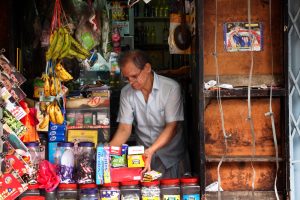Southeast Asian nations have suffered “unprecedented” employment losses due to the COVID-19 pandemic, the International Labor Organization (ILO) said today, suggesting that the region faces a long road out of its current Delta-variant maelstrom.
While the year 2020 marked the high-water mark of the COVID-19 pandemic in many places, for Southeast Asia, 2021 is shaping up as the true pandemic annus horribilis. Since the beginning of the year, the region has emerged as one of the global epicenters of the pandemic, with many countries currently recording their highest daily tolls of infection and death from the disease.
In a new policy brief released today, the ILO reveals that in 2020, there were 10.6 million (or 3.2 percent) fewer workers in employment in ASEAN countries than expected for 2020 in a no-pandemic scenario. The ASEAN region recorded working-hour losses of 8.4 percent relative to the fourth quarter of 2019.
“The impact of the pandemic on employment is unprecedented,” the brief stated. “Even during previous economic crises such as the Asian financial crisis in 1997 or the Great Recession in 2008-9, employment had always been on the rise in the ASEAN region.”
The ILO predicts that 2021 is on track to be nearly as bad as last year, in terms of the impact on the labor force. In 2021 and 2022, the ILO projects the employment gap to remain at 9.3 million and 4.1 million jobs, respectively. Meanwhile, this year could also see working-hour losses of up to 7.9 percent, not much better than last year’s 8.4 percent.
According to the brief, the nations have been battered by a number of factors, including “lockdown measures implemented by authorities to curb the spread of the virus, the dramatic decline in tourism, the decrease in domestic consumption as well as impacts through global supply chains.”
The impacts have also varied between nations. For instance, in 2020, the Philippines saw the largest working-hour losses, of 13.6 percent, while nations like Laos, Thailand, and Brunei saw smaller losses of around 4 percent. Among the reasons for this were the different structures of the region’s economies and governments’ varying ability to provide stimulus measures to keep workers in their jobs.
But it pointed out that the pandemic has not affected all workers to the same extent. Among the groups of workers who have been most impacted by job losses are women and young workers.
The problem now for Southeast Asian nations is that while many of them successfully contained the virus during 2020, this was purchased at significant economic cost. The regional economy contracted by 3.3 percent in 2020, after growing by 4.5 percent in 2019. In some cases, last year’s recession approached 10 percent.
But the regional resurgence of the virus in most Southeast Asian nations, which has remained stubbornly resistant to the lockdowns that ushered in last year’s successes, suggests that things are unlikely to get better soon.
Despite considerable vaccination progress by several nations – especially Singapore (68 percent of whose population is now fully vaccinated), Cambodia (40 percent), and Malaysia (29 percent) – Southeast Asia remains far from the widespread distribution necessary to quell the virus.
The region’s three most populous nations – Indonesia, the Philippines, and Vietnam – have fully vaccinated just 9.4 percent, 11 percent, and 1 percent of their populations, respectively. Meanwhile Thailand (6.9 percent), Brunei (9.5 percent), and Laos (17 percent) remain far from achieving widespread vaccination.
“With a continuing upward trend in the number of new cases and a relatively slow vaccine roll-out in most countries of the region, the adverse impacts on economies and labor markets in the region are unlikely to fade away any time soon,” the report states. “The labor market situation is likely to deteriorate further, as the pandemic continues to spread exponentially in large parts of the region.”
In 2020, Southeast Asian nations like Vietnam, Thailand, Cambodia, and Myanmar were the subject of puzzled inquiries as to the reason for their apparent immunity. The Delta variant has ended all of that. While governments will continue to bridge their peoples over with economic stimulus – the ILO observes that the ASEAN region had collectively allocated nearly 16 percent of GDP on its fiscal stimulus response as of the end of May 2021 – the pandemic is likely to leave an immense imprint on the region, as on the world.
Looking at the trajectory of past crises, it is worth recalling that the Asian financial crash of 1997-98 had a number of seismic flow-on effects. It catalyzed the collapse of Suharto in Indonesia, spurred the project of reformasi in Malaysia, and helped pave the way for the rise of Thaksin Shinawatra in Thailand – an event that still resonates in Thai political life.
The responses to the much more serious COVID-19 crisis will have to be correspondingly comprehensive. As the ILO’s briefing concluded, “The crisis has laid bare the vulnerabilities of the economies and labor markets in the region, which need to be tackled in order to build back better from the crisis and ensure a decent future of work in the ASEAN region.”
This will have to go beyond the barely adequate stimulus measures that most nations have implemented so far. Last month, Gerard McCarthy wrote in the Straits Times of the plight facing the region’s tens of millions of casual, contract, and informal workers, many of whom have fallen through the cracks of the present stimulus efforts, and in many cases taken on debt to ensure their survival during the pandemic downturn.
“A ‘new deal’ for Southeast Asia’s informal workers which expands safety nets and forgives survival debt is needed to ensure a robust and fair regional economic recovery,” McCarthy wrote. Given the wide discrepancies in national capacities, the ILO added in its briefing, “enhanced international solidarity and regional cooperation are critical to driving an inclusive, human-centered recovery.”
Barring such a “new deal” for the region’s workers, the political earthquakes will not be long in coming.

































